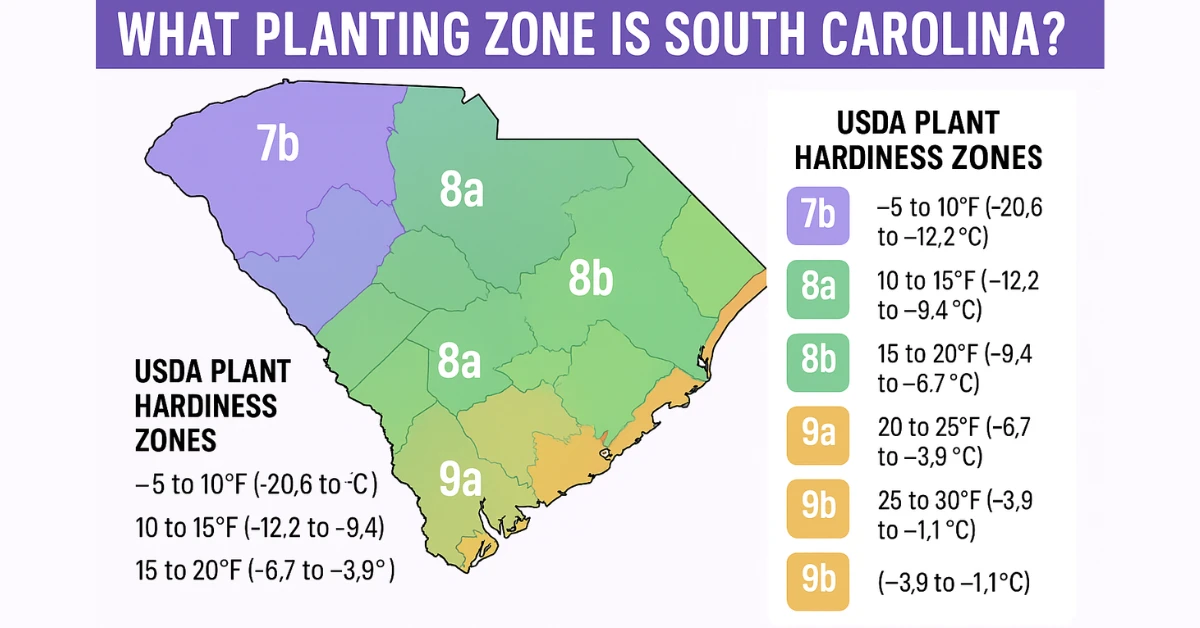What Planting Zone is South Carolina?[Map, Cities, and Growing Tips]

South Carolina’s planting zones range from 7a to 9a, with most of the state falling within zones 8a and 8b. Northern South Carolina includes zones 7a and 7b, while the coastal areas are primarily in zone 9a. These planting zones are based on USDA Hardiness Zone Maps and help gardeners determine which plants will survive and thrive in their region.
Understanding what planting zone is South Carolina is essential for successful gardening, especially if you want perennials, trees, or shrubs that can handle the state’s winters and long, hot summers.
📍 What planting zone is South Carolina?
| Region | USDA Planting Zone |
|---|---|
| Upstate (e.g., Greenville, Spartanburg) | Zone 7b |
| Midlands (e.g., Columbia, Sumter) | Zone 8a |
| Lowcountry (e.g., Charleston, Beaufort) | Zone 9a |
If you’re wondering what planting zone is South Carolina, remember that elevation and proximity to the coast are key factors. The Upstate is cooler, while the Lowcountry enjoys a milder, warmer climate year-round.
🌿 Why Planting Zone in South Carolina Matters?
Knowing what planting zone is South Carolina helps you:
- Select plants that can survive winter lows
- Plan your vegetable garden with proper timing
- Choose perennials, shrubs, and trees suited to your region
- Avoid costly planting mistakes (like trying to grow a Zone 4 plant in Zone 9)
For example, a gardener in Charleston (Zone 9a) can grow citrus trees outdoors, while a gardener in Greenville (Zone 7b) would need to overwinter citrus in containers.
🌡️ Average Temperatures & Growing Conditions
Here’s a breakdown of South Carolina’s planting zones and their average minimum winter temperatures:
| Zone | Winter Low Temperatures |
|---|---|
| Zone 7a | 0°F to 5°F |
| Zone 7b | 5°F to 10°F |
| Zone 8a | 10°F to 15°F |
| Zone 8b | 15°F to 20°F |
| Zone 9a | 20°F to 25°F |
These ranges define what planting zone is South Carolina and help gardeners select cold-hardy plants accordingly.
🧑🌾 When to Plant in South Carolina (By Zone)
| Crop Type | Zone 7b Start | Zone 8a Start | Zone 9a Start |
|---|---|---|---|
| Cool-season crops | Feb–Mar | Jan–Feb | Dec–Jan |
| Warm-season crops | Apr–May | Mar–Apr | Feb–Mar |
| Perennials | Spring/Fall | Spring/Fall | Fall preferred |
The warmer your zone, the longer your growing season. Knowing what planting zone is South Carolina ensures you plant at the right time for maximum success.
🌾 Real-World Gardening Example: Tomatoes & Perennials
If you’re in Columbia (Zone 8a), you can start tomato plants outdoors in early April. Meanwhile, in Charleston (Zone 9a), you might plant as early as February. Gardeners in Greenville (Zone 7b) should wait until late April to avoid frost damage.
Understanding what planting zone is South Carolina allows for smarter timing, healthier plants, and larger yields.
✅ Tips for South Carolina Gardeners
- Mulch heavily to retain moisture and regulate soil temps.
- Watch for high humidity pests (like aphids and mildew).
- Use raised beds in sandy or clay-heavy soils.
- Rotate crops to avoid soil-borne diseases.
🗺️ Check Your Exact Zone by Zip Code
For precision, check your planting zone using the USDA Plant Hardiness Zone Map with your zip code. While most of South Carolina falls in zones 8a and 8b, localized microclimates may slightly adjust what planting zone is South Carolina for your area.
🛠️ Useful Tools for South Carolina Gardeners
- Soil Volume Calculator – Know exactly how much soil you need for raised beds.
- Plant Spacing Calculator – Prevent overcrowding and maximize yield.
- Indoor Plant Watering Calculator – Perfect for your houseplants or container garden.
These tools complement your knowledge of what planting zone is South Carolina by helping you plan and maintain your garden effectively.
🙋 Frequently Asked Questions
What is the best planting zone for gardening in South Carolina?
Zone 8a, covering much of the Midlands, offers a balanced climate for a wide range of vegetables, flowers, and perennials.
Can I grow citrus in South Carolina?
Yes! In Zone 9a (coastal South Carolina), citrus like lemons and satsumas can be grown outdoors. In Zones 7b–8a, container growing is recommended.
When is the last frost in South Carolina?
- Zone 7b: Mid-April
- Zone 8a: Late March
- Zone 9a: Early March
📝 Conclusion: Know Your South Carolina Planting Zone
Understanding what planting zone is South Carolina is crucial for choosing plants, planning your garden, and ensuring year-round success. Whether you’re in the chilly Upstate or the warm Lowcountry, knowing your zone empowers you to plant smarter.
🌿 Start with your planting zone — and grow with confidence!
